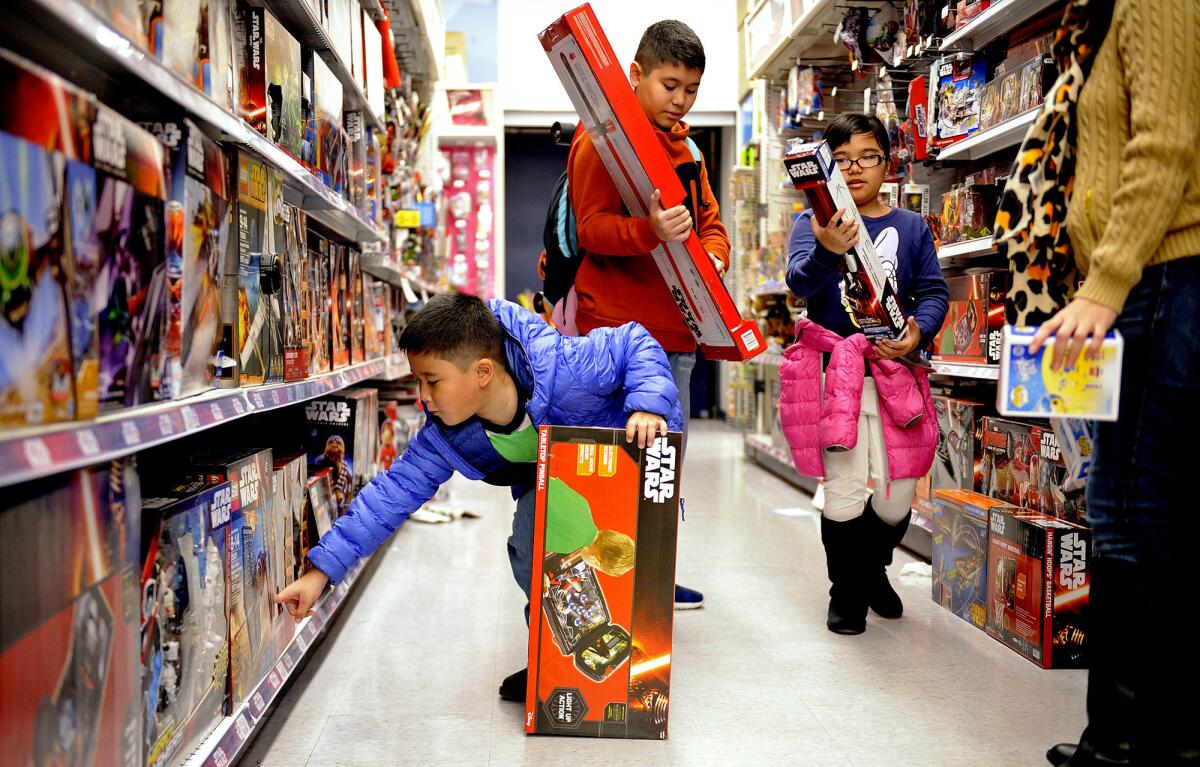December retail sales fall 0.1% as holiday shoppers remained restrained

From left, Inaki, 7, Inigo, 13, and Bianca Casido, 9, shop at a Toys R Us store in Los Angeles with their mother Kristine, right, on Dec.14, 2015.
- Share via
Holiday sales came in lower than expected, fresh data show, which has U.S. retailers starting the new year with a hard look at operations.
In December, retail sales fell 0.1% from the previous month, the Commerce Department said Friday. The National Retail Federation separately reported that sales during November and December increased 3% to $625.9 billion, below the forecasted 3.7% growth and under the 4.1% increase of the 2014 holiday season.
The subpar retail performance was reflected Friday in Wal-Mart Stores Inc.’s move to close 269 stores, with 154 in the U.S., including nine in California. That followed announcements from Macy’s and Kmart that those chains would close locations in California and other states.
Retailers have struggled to attract shoppers who are still budget-minded despite growth in the job market and a slow uptick in wages.
Even though motorists saved money on low gasoline prices, that failed to translate into significant boosts in consumer spending, which some economists had been predicting. Instead, many Americans appear to be squirreling away those extra dollars into savings or using the money to pay down debt.
“We do have more money as a whole, but the fact is consumers are very uncertain,” said Neil Saunders, chief executive of Conlumino, a retail consulting firm. “They are not saying it’s going great. They are saying things have gotten better, but we don’t know where they are going to go.”
The uncertainty has played out in the economy in the first few weeks of 2016. On Friday, the Dow Jones industrial average closed down 390.97 points, or 2.4%, to 15,988.08 amid plunging oil prices and chaos in Chinese stocks. Some economists worried that turmoil in China could drag down economies around the world.
The National Retail Federation pointed to cautious consumers who caused merchants to discount heavily at the expense of profits in November and December. In addition, warm temperatures hurt sales of sweaters and other cold-weather gear.
“Make no mistake about it, this was a tough holiday season for the industry,” said Matthew Shay, the trade group’s chief executive. Still, he contended, “sales grew at a healthy rate.”
A long-term worry for companies with many physical stores is the rush to online shopping, where sales grew 9% to $105 billion during the holidays, which was faster than expected, according to the group.
“Consumers are finding the online experience more immersive and entertaining,” said Noam Paransky, director of AlixPartners’ retail practice. “Retailers are realizing that with the limited capital available to them, they have got to accelerate that migration from brick-and-mortar to online.”
Reducing the roster of stores frees capital to experiment both online and offline. Along with amping up investment to their e-commerce arms, retailers have been testing different store formats as well, with various degrees of success.
Macy’s said it planned to open an additional 50 of its off-price Macy’s Backstage stores in the next two years (most of which will take up space within existing Macy’s locations). But Wal-Mart’s store closures included all of its Express locations, which had been a foray into a small format location.
“There is more focus on ‘We don’t need all these big-box stores, let’s look at different formats to meet new and changing consumer needs,’” Saunders said.
Another problem facing retailers: Many shoppers, especially young ones, are growing more interested in experiences such as dinners and movies with friends than in acquiring mounds of new clothes and other physical goods.
That could be seen in December, when sales at food and drinking establishments rose 0.8%, while clothing and accessories shops suffered a 0.9% drop, according to the Commerce Department.
Home improvement categories, which are linked with a desire to entertain, also saw growth. Furniture stores got a 0.9% boost. Building material and garden dealers reported a 0.7% increase.
“The consumer has more discretionary income,” Paransky said, “but the bad news for retailers is that we’re seeing a migration” of spending to experiences such as dining out and fixing up their homes.
That means retailers have to be more vigilant about which stores they will keep — and those they will shed.
There are still advantages to having physical shops, analysts said. Those locations can serve as mini distribution centers to fulfill online orders more quickly, for example; they become convenient sites for customers to pick up orders instead of waiting for home delivery.
Retailers can look at stores as “the glass half empty or half full,” Paransky said. “They have a more robust network they can leverage, but they have to figure out how to do that.”
shan.li@latimes.com
Twitter: @ByShanLi
More to Read
Inside the business of entertainment
The Wide Shot brings you news, analysis and insights on everything from streaming wars to production — and what it all means for the future.
You may occasionally receive promotional content from the Los Angeles Times.











